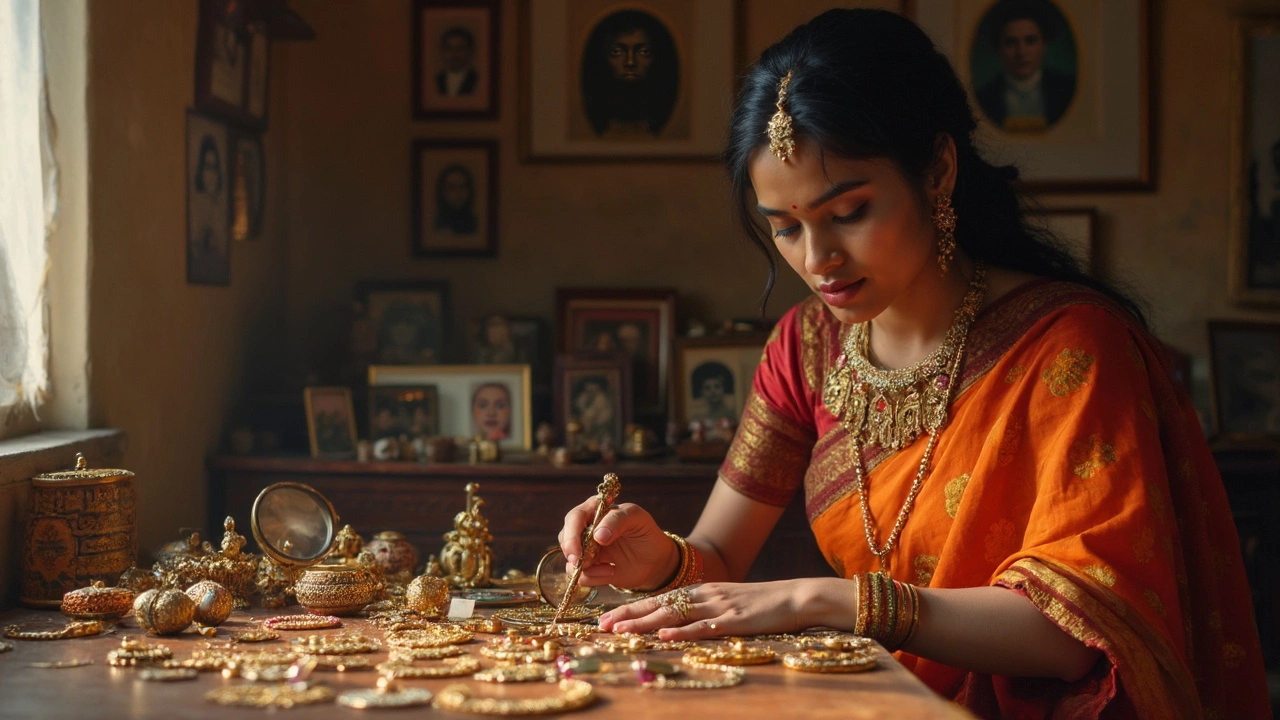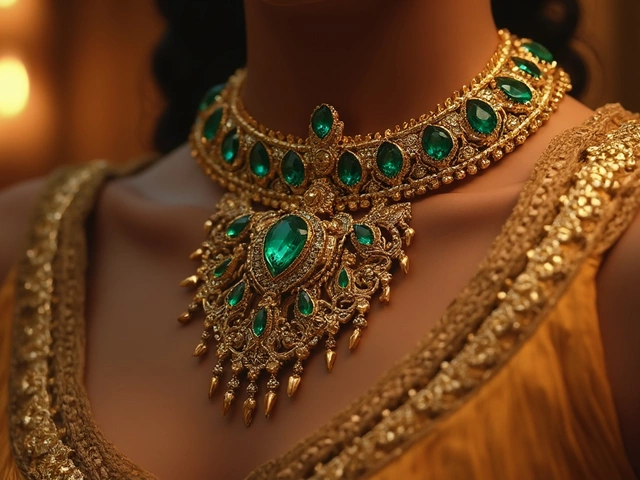Thinking about selling that old necklace or vintage ring tucked away in your drawer? Before you rush to the nearest shop, you need to know what you’ve actually got—and how to squeeze every penny from it.
Not every piece that looks old is worth a fortune, but some vintage and antique jewelry can surprise you. Sometimes, a simple design hides rare craftsmanship or historical value. One tiny marking on the inside of a band—like 18k or the name of an old jeweler—can mean you’ve just hit the jackpot.
Savvy sellers always start by getting the facts. Skip the guesswork and step one is learning what makes certain pieces valuable. Age, brand, and materials matter, but so does the story behind the item. Heard of someone finding a $10,000 brooch in grandma’s box? That's not fantasy—it happens when you know what to look for.
- Spot the True Value: What’s Really Worth Money?
- Getting a Trustworthy Appraisal
- Clean Up, But Don’t Overdo It
- Where to Sell: Shops, Auctions, or Online?
- Negotiating Like a Pro
- Red Flags, Scams, and Rookie Mistakes
Spot the True Value: What’s Really Worth Money?
You’re staring at a box of old jewelry, and it’s easy to wonder: is this real treasure or just stuff? The answer is all in the details—knowing what to check sets big payouts apart from letdowns.
First, look for materials. Solid gold and platinum pieces always beat out anything just gold-filled or plated. Sterling silver is valuable too, but not as much as gold. Keep an eye out for hallmarks like “18k,” “14k,” “PLAT,” or “925” stamped somewhere on the piece. These marks mean quality, not costume.
Design and age matter more than you’d think. Art Deco pieces from the 1920s and Victorian items from the 1800s are hot right now in the antique jewelry market. Brands like Cartier and Tiffany—even if they’re not gold—can bring in thousands.
Let’s get specific: Diamonds aren’t always king. Certain colored stones, like untreated sapphires or Burmese rubies, might be worth more per carat. Pearls are hit or miss—natural ones can sell for huge prices, but most post-1950 cultured pearls are fairly common.
- Original packaging, receipts, or certificates push the value up.
- Unusual shapes, hand engraving, and old work (think screw-back earrings or filigree) signal something special.
- Any historic connection or signed designer name is usually a win.
Check out this rough breakdown of things people often find and what they might bring at sale, assuming good condition and authentic pieces:
| Item Type | Possible Value Range (USD) |
|---|---|
| Victorian Gold Ring | $500 - $2,000 |
| Art Deco Diamond Brooch | $1,200 - $8,000 |
| Tiffany & Co. Silver Necklace | $300 - $1,500 |
| Sapphire Engagement Ring (untreated) | $2,000 - $10,000+ |
| Vintage Costume Jewelry | $20 - $250 |
If you’re not sure, take clear photos and do a quick online check for similar items. eBay sold listings or auction catalogs work, but don’t trust just one source. At the end of the day, value is all about rarity, materials, and what buyers want right now.
Getting a Trustworthy Appraisal
If you jump right into selling without a real appraisal, you’re basically hoping for the best. The truth? Having your antique jewelry professionally appraised is the fastest way to figure out its real value. Not all appraisers are created equal, though—it pays to find someone legit.
Here’s what you need to know: look for an independent appraiser, not someone who’s also trying to buy your jewelry. That way, you’re more likely to get an honest opinion and not a lowball price. The best bet is to go for someone certified by the Gemological Institute of America (GIA), the American Gem Society (AGS), or the National Association of Jewelry Appraisers (NAJA). These folks have to play by some serious rules.
Appraisals usually take into account:
- Type and purity of any gold, silver, or platinum
- Quality and size of stones (diamonds, sapphires, rubies, etc.)
- Craftsmanship and age
- Any unique historical or designer marks
If your jewelry is from a brand like Cartier or Tiffany, mention that right away—sometimes the brand is worth more than the materials alone. Don’t forget, most professional appraisals cost money. Fees usually range from $50 to $150 an hour depending on the complexity. Get a flat-fee quote upfront if you can, so you’re not surprised later.
Here’s a quick breakdown of what appraisers typically check:
| What Appraisers Look At | Why It Matters |
|---|---|
| Hallmarks/Signatures | Shows designer, origin, or age |
| Metal purity stamps | Affects scrap and resale value |
| Stone grading | Impacts price, especially with diamonds |
| Condition | Damaged pieces fetch less |
| Historical context | Rare periods boost value |
And always ask for a written appraisal report. It’s not just a number on a sticky note—it should break down why your piece is worth what they claim. With that in hand, you’ll have solid backup to show any future buyer or another appraiser, and you’ll look like you know what you’re doing.
Clean Up, But Don’t Overdo It
It’s tempting to polish your jewelry until it shines like new, but here’s the thing: with antique jewelry, you can actually do more harm than good. Harsh cleaners, buffing wheels, or even a bit too much elbow grease can knock off original finishes or damage delicate details—that’s the stuff collectors and buyers are really after.
Before you pull out any cleaning products, always check for signs of fragile stones, enamel work, or settings that look a little wobbly. If you spot anything loose, don’t mess with it yourself. You could easily lose a gemstone or snap an old clasp.
- Use a soft, dry cloth or a toothbrush with gentle bristles just to dust off grime.
- Skip soaking in water, especially if the piece has pearls, opals, or glued components—those don’t handle moisture well.
- Never use commercial jewelry cleaners on vintage or antique pieces. These can strip away patina, which is often proof of age and what makes your jewelry sell for more.
For items that seem valuable or especially dirty, consider taking them to a jeweler who’s got experience with antiques. They’ll know what to protect and won’t go overboard. Most of the time, a light dust or gentle wipe is all you need to show off an old piece’s natural beauty. Buyers looking for something authentic can spot a relic that’s been messed with from a mile away, and they value the real character far more than a modern sparkle.

Where to Sell: Shops, Auctions, or Online?
So, you’ve figured out you’ve got something special. Now comes the big question: where’s the best place to get serious cash for your antique jewelry? There’s no single answer, but your choice could change what you walk away with by hundreds or even thousands of dollars.
Let’s break down the main selling options:
- Local Jewelry Shops & Pawn Shops: Easy and quick, but usually the worst deal. Shops have to resell your piece, so they offer 40–60% of the resale value on average. If you need cash right now and don’t care about losing some profit, this is simple, but don’t expect a high payout.
- Antique Dealers: A step up, but results vary. Some are experts and pay fairly for unique items. Always shop around—get two or three offers before making a deal. Dealers can spot real value, but they’re still looking for profit on resale.
- Auctions: Perfect for rare or valuable pieces. Big names like Sotheby’s and Christie’s are known for jaw-dropping sales, but they also charge hefty fees (up to 20% commission). Local auction houses often do estate sales and vintage jewelry events, which could land you a better price if your piece is in demand.
- Online Marketplaces: The widest audience and sometimes the best prices. But also the most hassle. Sites like eBay, Etsy (for vintage/pre-1980s), and 1stdibs reach a global market, but make sure you’re up for answering lots of messages and dealing with shipping. Watch for online scams—always double-check buyer ratings and use secure payment platforms.
Want to see how selling methods compare? Check the numbers:
| Selling Option | Expected Payout (% of Potential Value) | Speed | Risk/Downside |
|---|---|---|---|
| Pawn Shop | 40–60% | Immediate | Lowest payout, little room to negotiate |
| Antique Dealer | 60–70% | Same-day to a week | Dealer markup, less transparent |
| Auction House | Up to 90% (minus fees) | Weeks to months | Unpredictable, high fees, must wait |
| Online Marketplace | 70–95% | Days to months | Scams, shipping risks, time commitment |
Stuff to keep in mind:
- If your jewelry is worth more than $1,000, skip pawn shops completely.
- For super rare or high-end pieces, professional auction houses often attract the right crowd—but watch out for commission fees eating a big chunk of your profit.
- Online selling takes more effort, but you usually get buyers willing to pay for stories, history, and detail—especially with vintage or one-of-a-kind pieces.
Bottom line—don’t rush it. Line up your options, calculate possible fees, and go for the route that fits your patience, safety, and profit goals.
Negotiating Like a Pro
When it comes to selling antique jewelry, being able to negotiate is nearly as important as knowing what you have. Buyers—whether it’s a pawn shop, online dealer, or auction house—are out to make a profit. They usually throw out a first offer that’s on the low side. Don’t let that put you off or make you feel rushed. Always remember, you’re in control until you hand over your piece.
Before you step into a deal, do your homework. Research recent sale prices for pieces like yours. Sites like Worthy.com and LiveAuctioneers publish real selling prices. Like, as of 2024, a signed Victorian brooch in good shape can fetch $800-$1,500 at auction—way more than what some local shops might offer.
If you get an offer, don’t answer right away—even a short pause shows you’re thinking. If you have an official appraisal or know the antique jewelry history, bring it up. Show your facts with confidence—buyers respect clear numbers, not vague stories.
- Always have a minimum price in your head. Never sell below this, even if you feel pressured.
- When a buyer lowballs you, ask politely why the offer is so low. Real pros will explain. If a buyer won’t share their logic, that’s a red flag.
- Let buyers know you’re exploring other options and offers. This keeps you from looking desperate to sell, which can drive the price up.
- If you’re selling more than one item, negotiate the bundle. Dealers often pay more per piece if they’re taking a group.
Here’s a quick breakdown comparing typical first offers, real fair value, and average auction prices for common items:
| Item | Pawn/Dealer First Offer | Fair Appraised Value | Average Auction Price |
|---|---|---|---|
| Victorian Gold Ring | $200 | $450 | $650 |
| Art Deco Diamond Brooch | $400 | $1,100 | $1,350 |
| Edwardian Pearl Necklace | $150 | $400 | $620 |
Remember, your goal is to walk away feeling good about the deal, not wondering if you were taken for a ride. Stand your ground, show your research, and don’t sell just because someone is rushing you. You’ll usually end up with a better offer—sometimes hundreds or thousands higher—just by taking your time and asking the right questions.
Red Flags, Scams, and Rookie Mistakes
If you’re not careful, selling antique jewelry can quickly turn into a headache—or worse, an expensive lesson. Way too many people lose cash or priceless pieces to scammers because they don’t spot the warning signs. Here’s how to recognize trouble before it finds you.
- Too-Good-to-Be-True Offers: That buyer online offering double what everyone else offers? Hard pass. Real buyers base offers on gold weight, gemstones, and actual demand—not wild promises. If it sounds fishy, it probably is.
- Lack of Credentials: Never deal with someone who can’t prove their credentials. A legit jeweler or appraiser should show you their business license or professional membership (like GIA, NAJA, or a local jewelers’ association). Shady "pop-up" dealers at sketchy hotels are a classic scam.
- Pressure to Sell Fast: Scammers want you to decide quick. They say things like “This deal is only good for today!” or “I need to pay cash right now.” Slow down. Real buyers respect your pace.
- No Written Offer: Always get written quotes, not just a handshake or a vague text. If things go south, you need a record.
- Not Returning Items: Some shops or "appraisers" offer to take your piece for evaluation and then ghost you. Never leave your jewelry behind without paperwork and clear terms.
When it comes to rookie mistakes, these slip-ups cost people the most:
- Cleaning Too Much: Scrubbing jewelry can knock out stones or erase patina, killing its value. Unless a pro tells you otherwise, leave it as-is.
- Skipping the Appraisal: Jumping straight to the first offer means you could be missing out on hundreds—or thousands. Pay for at least one independent appraisal if your item looks valuable.
- Selling to the Wrong Place: Pawn shops pay the fastest, but you might get 30–60% less than at a specialty auction or reputable dealer. Don’t trade speed for real money.
Here’s a quick look at the most common loss situations reported by US sellers in 2024:
| Scam or Mistake | Percent of Reported Losses |
|---|---|
| Fake Appraisers | 39% |
| Lowball Offers from Pawn Shops | 28% |
| Online Sale Scams | 21% |
| Items Not Returned After Evaluation | 12% |
Watch for these warning signals, don’t get rushed, and always check who you’re dealing with. That way, you hold onto both your cash and your peace of mind.



